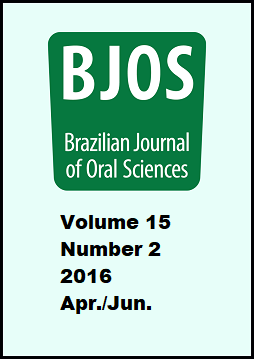Abstract
Aim: To evaluate the association of environmental risk factors, particularly paternal and maternal age, with gender and type of oral cleft in newborn with nonsyndromic cleft lip with or without cleft palate (NSCL/P). Methods: This study included 1,346 children with NSCL/P of two Brazilian Services for treatment of craniofacial deformities. Parental ages were classified into the following groups: maternal age <35, 36-39, and ≥40 years; paternal age <39 and ≥40 years. The data was analyzed with chi-square test and multinomial logistic regression analysis. The odds ratios were estimated with a 95% confidence interval. Results: Of the 1,346 children included in this study, CLP was the type of NSCL/P with highest prevalence, followed by, respectively, CL and CP. There was a greater occurrence of NSCL/P in males compared to females (55.8% versus 44.2%). CLP was more common in men, while the CL and CP were more prevalent in women (p=0.000). No association between maternal age and clefts was observed (p=0.747). However, there was evidence of association between father’s aged ≥40 years old and NSCL/P (p=0.031). When patients with CP were analyzed separately, no association between the father’s age and the child’s gender (p=0.728) was observed, i.e. the female gender prevails among patients with CP, regardless of the father’s age. Conclusions: This study showed that there were differences in the distribution of the non-syndromic cleft lip and/or palate and the gender, and fathers aged ≥40 years old may have increased risk of oral cleft. Further studies involving different populations are needed for a better understanding of the effect of maternal and paternal ages as a risk factor for the occurrence of oral clefts.
References
Leslie EJ, Marazita ML. Genetics of cleft lip and cleft palate. Am J Med Genet C Semin Med Genet. 2013 Nov;163C(4):246-58.
Rahimov F, Jugessur A, Murray JC. Genetics of nonsyndromic orofacial clefts. Cleft Palate Craniofac J. 2012;49(3):73-91.
Martelli-Junior H, Porto LC, Martelli DRB, Bonan PR, Freitas AB, Coletta RD. Prevalence of nonsyndromic oral clefts in a reference hospital in Minas Gerais State, between 2000-2005. Braz Oral Res. 2007;21(4):3147.
Rodrigues K, Sena MF, Roncalli AG, Ferreira MA. Prevalence of orofacial clefts and social factors in Brazil. Braz Oral Res. 2009;23(4):38-42.
Dixon MJ, Marazita ML, Beaty HT, Murray JC. Cleft lip and palate: understanding genetic and environmental influences. Nature. 2011;12(6):167-78.
Genisca AE, Frias JL, Broussard CS. Orofacial clefts in the National Birth Defects Prevention Study, 1997–2004. Am J Med Genet A. 2009;149A:1149-58.
Meng L, Bian Z, Torensma R, Van der Hoff JW. Biological mechanisms in palatogenesis and cleft palate. J Dent Res. 2009;88(1):22-33.
Spina V, Psillakis JM, Lapa FS, Ferreira MC. Classificação das fissuras lábio-palatinas. Rev Hosp Clin Fac Med S Paulo. 1972;27(2):5-6.
Martelli DR, Machado RA, Swerts MS, Rodrigues LA, Aquino SN, Martelli Júnior H. Non syndromic cleft lip and palate: relationship between sex and clinical extension. Braz J Otorhinolaryngol. 2012;78(5):116-20.
Conway JC, Taub PJ, Kling R, Oberoi K, Doucette J, Jabs EW. Ten-year experience of more than 35,000 orofacial clefts in Africa. BMC Pediatr. 2015;14(15):8.
Calzolari E, Pierini A, Astol G, Bianchi F, Neville AJ, Rivieri F. Associated anomalies in multi-malformed infants with cleft lip and palate: An epidemiologic study of nearly 6 million births in 23 EUROCAT registries. Am J Med Genet A. 2007 Mar 15;143A(6):528-37.
Mossey P, Castillia E. Global registry and database on craniofacial anomalies. Geneva: World Health Organization, 2003.
Berg E, Lie RT, Sivertsen Å, Haaland ØA.Parental age and the risk of isolated cleft lip: a registry-based study. Ann Epidemiol. 2015 Dec;25(12):942-7.e1.
Setó-Salvia N, Stainer P. Genetics of cleft lip and/or cleft palate: Association with other common anomalies. Eur J Med Genet. 2014;57(8):381-93.
Zhang B, Jiao X, Mao L, Xue J. Maternal cigarette smoking and the associated risk of having a child with orofacial clefts in China: a case- control study. J Craniomaxillofac Surg. 2011 Jul;39(5):313-8.
Luo YL, Cheng YL, Gao XH, Tan SQ, Wang W, Chen Q. Maternal age, parity and isolated birth defects: a population-based case-control study in Shenzhen, China. Plos. 2013;8(11):e81369.
Bufalino A, Paranaiba LMR, Aquino SN, Martelli Júnior H, Swerts MSO, Coletta RD. Maternal polymorphisms in folic acid metabolic genes are associated with nonsyndromic cleft lip and/or palate in the Brazilian population. Birth Defects Res A Clin Mol Teratol. 2010;88(7):980-6.
Herkrath APCQ, Herkrath FJ, Rebelo MAB, Vettore MV. Parental age as a risk factor for non-syndromic oral clefts: a meta-analysis. Journal of Dentistry. 2012;40(6):3-14.
Aquino SN, Messeti AC, Hoshi R, Borges A, Viena CS, Reis SA et al. Analysis of Susceptibility Polymorphisms for Nonsyndromic Cleft Lip with or without Cleft Palate in the Brazilian Population. Birth Defects Res A Clin Mol Teratol. 2014;100(2):36-42.
Moreira HSB, Machado RA, de Aquino SN, Rangel ALC, Martelli-Júnior H, Coletta RD. Epidemiological features of patients with nonsyndromic cleft lip and/or palate in Western Parana. Braz J Oral Sci. 2016;15(1):3944.
Campos Neves AT, Volpato LE, Espinosa MM, Aranha AM, Borges AH. Environmental factors related to the occurrence of oral clefts in a Brazilian subpopulation. Niger Med J. 2016 May-Jun;57(3):167-72.
Vieira AR, Orioli IM, Murray JC. Maternal age and oral clefts: a reappraisal. Oral Surg Oral Med Oral Pathol Oral Radiol Endod. 2002;94(5):530-5.
The Brazilian Journal of Oral Sciences uses the Creative Commons license (CC), thus preserving the integrity of the articles in an open access environment.

